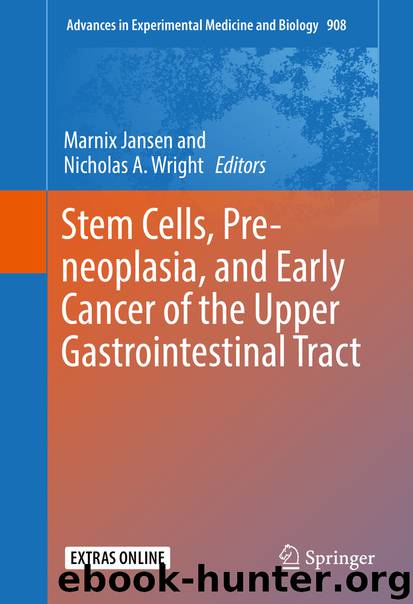Stem Cells, Pre-neoplasia, and Early Cancer of the Upper Gastrointestinal Tract by Marnix Jansen & Nicholas A. Wright

Author:Marnix Jansen & Nicholas A. Wright
Language: eng
Format: epub
Publisher: Springer International Publishing, Cham
Dysregulation of Wnt Signaling and Cell Adhesion Genes
Catenins and the transmembrane protein E-cadherin are required for the maintenance of adherens junctions binding epithelial cells together. Loss of E-cadherin leads to the disruption of the adhesion complex, loss of contact inhibition and, consequently, uncontrolled cell growth [42]. For this reason, interference of cell adhesion is considered an early event in oncogenesis [43]. Reduced expression of E-cadherin is observed in BO and in OAC where significant absence of E-cadherin is correlated with poor cell differentiation and survival [44]. Although LOH and epigenetic silencing of the E-cadherin locus is frequent, mutations in E-cadherin are not common. Dulak and colleagues reported frequency of mutation and loss of only 3 and 4 %, respectively, in 149 OAC tumors [17]. In one study involving cadherin–catenin complex, more than 75 % (60/80) of OAC and lymph node samples showed reduction of E-cadherin, alpha-catenin, and beta-catenin expression. In this study, low expression levels of all three proteins correlated with high tumor grade and shorter patient survival [45]. This correlation is consistent with a separate study where 42 out 59 OAC displayed reduced or absent membranous E-cadherin [43].
Overexpression of the receptor tyrosine kinase Ephrin B3 (Eph B3) inhibits cell growth and its activity is reduced in OAC. Simultaneous expression of Eph B3 and translocation of E-cadherin to the membrane correlated inversely to tumor stage [46].
The Wnt signaling pathway is responsible for promoting the intestinal architecture [47]. It downregulates the expression of cadherins [48] and upregulates the expression of the proto-oncogene beta-catenin [49]. Since OAC develops from an intestinal metaplasia background, Moyes et al. have explored whether aberrant Wnt signaling is activated in the development of BO and/or dysplasia. The authors reported that high-grade dysplasia was correlated with nuclear localization of beta-catenin and upregulated expression of Wnt target genes cyclin D1, Sox-9, and c-myc. This activation of the Wnt signaling pathway was not observed in nondysplastic tissue samples [50]. Increased activity of the Wnt pathway can also be due to the increased expression of the Wnt ligand WNT2. Clement et al. reported that OAC samples had significantly higher levels of WNT2 mRNA when compared with normal and nonmalignant tissue samples. In addition, cancer and dysplastic samples displayed reduction in levels of Wnt inhibitors SFRP1 and SFRP2 [51].
Download
This site does not store any files on its server. We only index and link to content provided by other sites. Please contact the content providers to delete copyright contents if any and email us, we'll remove relevant links or contents immediately.
The Art of Coaching by Elena Aguilar(52204)
Thinking, Fast and Slow by Kahneman Daniel(11803)
The Art of Thinking Clearly by Rolf Dobelli(9930)
The 5 Love Languages: The Secret to Love That Lasts by Gary Chapman(9293)
Mindhunter: Inside the FBI's Elite Serial Crime Unit by John E. Douglas & Mark Olshaker(8718)
When Breath Becomes Air by Paul Kalanithi(8043)
Periodization Training for Sports by Tudor Bompa(7929)
Becoming Supernatural by Dr. Joe Dispenza(7845)
Turbulence by E. J. Noyes(7716)
Bodyweight Strength Training by Jay Cardiello(7680)
Therapeutic Modalities for Musculoskeletal Injuries, 4E by Craig R. Denegar & Ethan Saliba & Susan Saliba(7601)
The Road Less Traveled by M. Scott Peck(7284)
Nudge - Improving Decisions about Health, Wealth, and Happiness by Thaler Sunstein(7260)
Mastermind: How to Think Like Sherlock Holmes by Maria Konnikova(6942)
Enlightenment Now: The Case for Reason, Science, Humanism, and Progress by Steven Pinker(6879)
Win Bigly by Scott Adams(6832)
Kaplan MCAT General Chemistry Review by Kaplan(6603)
Why We Sleep: Unlocking the Power of Sleep and Dreams by Matthew Walker(6363)
The Way of Zen by Alan W. Watts(6292)
